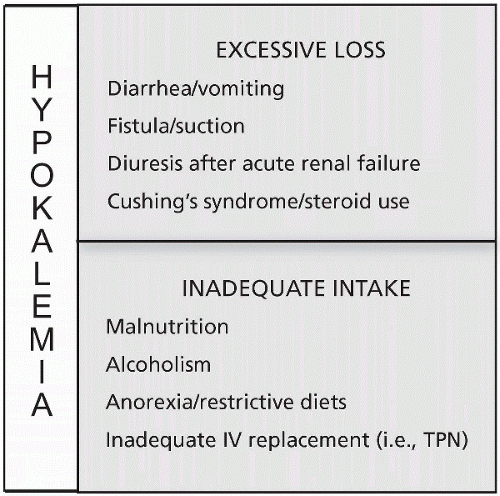Hypokalemia
QUICK LOOK AT THE CHAPTER AHEAD
A serum level of potassium below 3.5 mEq/L is considered hypokalemia. A low potassium level results from an inadequate intake, excessive loss, or a shift of potassium from the extracellular compartment to the intracellular compartment. The loss of potassium through such events generally takes place slowly over time. Here we discuss the causes, manifestations, and treatment of hypokalemia.
Hypokalemia is defined as a serum level of potassium below 3.5 mEq/L. When an inadequate intake, excessive loss, or a shift of potassium from the extracellular compartment to the intracellular compartment occurs, a low potassium level results.
Decreased Intake of Potassium
Insufficient potassium intake can occur from an improper diet. Fad diets or administration of large amounts of potassium-deficient intravenous fluids could result in hypokalemia (Table 16-1).
Table 16-1 Causes of Hypokalemia | |||||||||
|---|---|---|---|---|---|---|---|---|---|
|
Excessive Loss of Potassium
A large loss of potassium could occur with excessive use of diuretics. Potassium is lost via urine. Overuse of diuretics or use of diuretics that are too potent without potassium supplementation could result in hypokalemia. Intestinal fluids are also rich in potassium. Laxative abuse or loss of fluids through the gastrointestinal system due to suction, vomiting, diarrhea, or fistulas can lead to a loss of potassium. Insulin, which shifts potassium into the cell; corticosteroids; and certain antibiotics can also be responsible for depleting potassium from the body.
Stay updated, free articles. Join our Telegram channel

Full access? Get Clinical Tree




